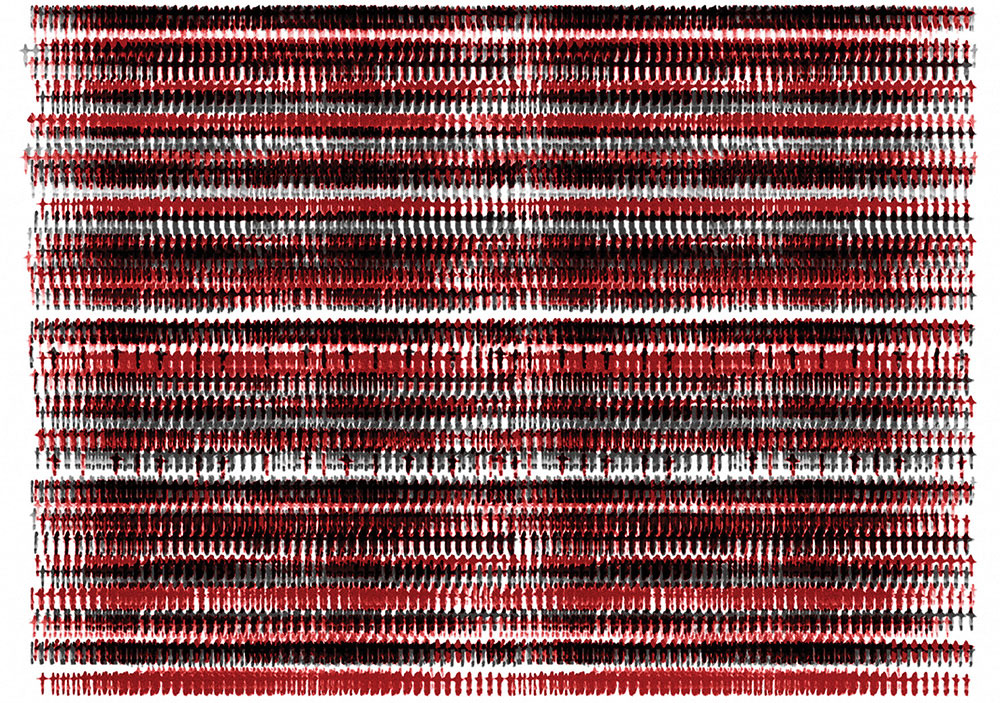ART CITIES:Geneva-Michal Rovner
 As a result of her desire to produce work that is free from narrative, or indeed people with any distinguishable features, the work of Michal Rovner possesses a distinct timelessness. Through editing videos of real people moving around slowly together in an abstracted environment, the artist creates new and immersive worlds for the viewer. Though some of her work is political, the artist says that it is broadly concerned with the human condition.
As a result of her desire to produce work that is free from narrative, or indeed people with any distinguishable features, the work of Michal Rovner possesses a distinct timelessness. Through editing videos of real people moving around slowly together in an abstracted environment, the artist creates new and immersive worlds for the viewer. Though some of her work is political, the artist says that it is broadly concerned with the human condition.
By Dimitris Lempesis
Photo: Pace Gallery Archive
Since her landmark exhibition at the Venice Biennale in 2003, Rovner has expanded her innovations in many directions, backward, into the historical realm defined by the ancient stones she used as both medium and context; and forward into technological systems that allow for novel expression of her imagery.At a slight distance, Michal Rovner’s video works and prints on view at Pace Gallery for her solo exhibition “Evolution” appear to be a series of bar codes or foreign text. But as you approach the work becomes much clearer. “If you look at it for a bit you’ll see it’s multiplying: it’s becoming two, and it’s becoming one,” she says of the moving tic-tac shaped forms splitting apart, mutating, and merging on the screen. “At the same time, each one is a person”. In “Mechanism” (2018), one of the central pieces of the exhibition, a massive amount of tiny human figures rotate like a cogwheel, becoming part of a large mechanism. “We, ourselves are becoming almost like microchips in a big system, a mechanism of the future”. In Rovner’s return to her unique, abstracted language, which consists of duplicated patterns of human movements, she has intensified this visual language. The human figures have lost basic contours, to the point that their humanity becomes difficult to identify. The movement, which apparently repeats itself, has become wilder. The lines, structures and patterns change more rapidly and recall a sense of urgency and warning that permeate our world. By erasing the identifying details, the figures also become universal, it could be someone you know, a stranger, or it could be you. Rovner is interested in exploring humanity and the human condition, and particularly how communication is impacted in the wake of a tech-first world. Michal Rovner was born in 1957 in Tel Aviv. She studied cinema, television, and philosophy at Tel Aviv University before enrolling at the Bezalel Academy of Arts and Design in Jerusalem in 1981, receiving a BFA in photography and art in 1985. In 1978, with artist Arie Hammer, she co-founded the Camera Obscura School of Art in Tel Aviv, the city’s first school for photographers. She moved to New York in 1987. In the early 1990s, she worked with director Robert Frank on two films, “One Hour-C’est Vrai” (1990), an experimental film for French television, and “Last Supper” (1992), which she cowrote. In her early photography series “Outside” (1990-91), Rovner took an image of a Bedouin shack in the Israeli desert and printed and reprinted it, distorting its size and color. For the “Decoy” series (1991), she distorted radar and surveillance images to create photographs of indistinct groups of people with blurred features. In “One-Person Game Against Nature” (1992–93), she again distorted images, this time her own photographs of people floating in the Dead Sea. In 1996, Rovner began to use film and video, creating works featuring anonymous crowds of people or animals, as in “Monoprints of Birds” (1998). While she has eschewed direct political commentary in her work, in 1995-96 she produced installations for the Israel-Lebanon border that were situated on electric fences and guard towers in the line of ongoing exchanges of fire. These were complemented by her video “Border” (1996-97), in which she futilely attempted to demarcate and cross the border from Israel into Lebanon. Her video “Notes” (2001) was a collaboration with the composer Philip Glass; Rovner used footage of a group of people walking on an inclined angle, and Glass composed music inspired by this moving image. “Time Left” (2002), a multichannel-video installation comprising images of endless rows of indistinct beings, was the centerpiece of her mid-career retrospective at the Whitney Museum of American Art in New York in 2002. For the exhibition “Stone” (2004), she mixed sculpture and video by projecting minute images of crowds onto tablets of stone, blurring the line between image and text. In the film “Fields of Fire” (2005), Rovner’s images of oilfields in the Republic of Kazakhstan reflect the persistent instability of a region at the epicenter of international scrutiny. “Living Landscape” (2005), a site-specific video wall at Yad Vashem in Jerusalem, projects a montage of pre-WWII footage of dances, music, and daily lives of European Jews.
Info: Pace Gallery, Quai des Bergues 15-17, Geneva, Duration: 30/1-18/4/19, Days & Hours: Tue-Sat 10:00-18:00, www.pacegallery.com

